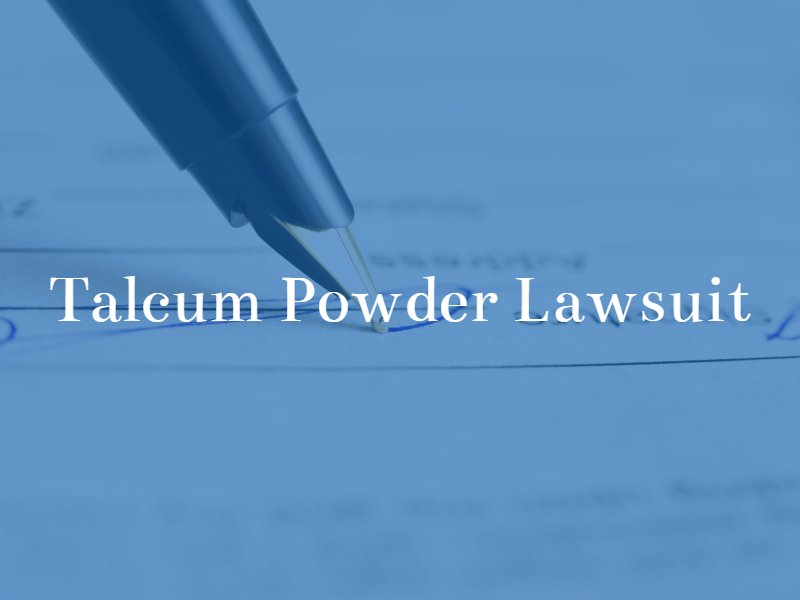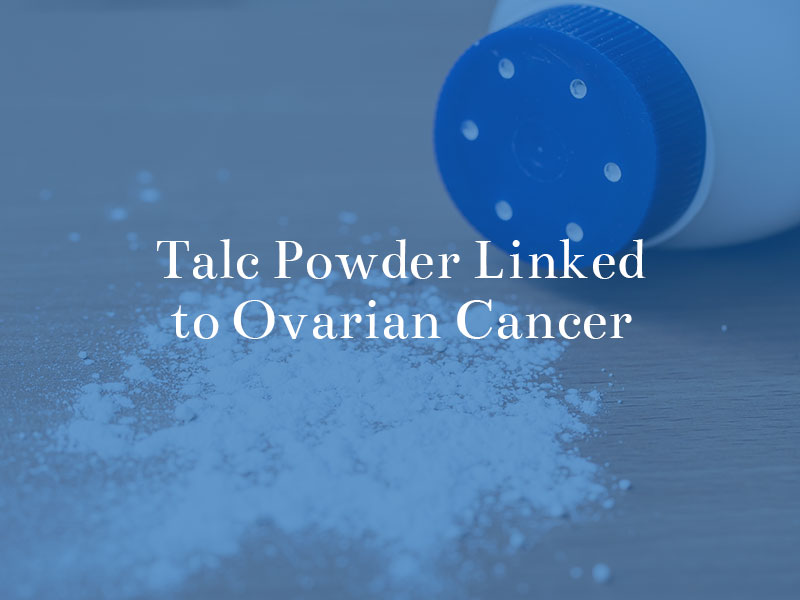A Voice for the Voiceless
The Dunken Law Firm is committed to helping each client find their voice and recover what has been lost.
START MY FREE CONSULTATIONTalc is comprised of magnesium, silicon and oxygen. It is the main ingredient in popular branded talcum products such as Shower to Shower and Johnson’s Baby Powder. Talc was used in these products for its ability to reduce friction and absorb moisture. Known as a mineral with the softest properties, talc has been used in cosmetic powders and other makeup products as well. Popular concentrations of talc, such as those made by consumer goods giant Johnson & Johnson, allegedly including the known carcinogen asbestos, have been linked to users developing both mesothelioma and ovarian cancer. The company continues to face thousands of mesothelioma and ovarian cancer-related talc claims nationwide, in state and federal court.

Talcum powder, also known as talc, is a mineral in clay mined from underground deposits and contains hydrated magnesium silicate. Talc is the softest mineral in the world, which makes it useful for many products in the beauty and personal care industry. It is typically added to soften products, make makeup opaque, absorb moisture, and prevent caking. It is most well known for its use in baby powder. However, talcum can be found in many other products, such as:
Talcum powder is frequently used to decrease moisture and friction on the skin. It has the ability to prevent rashes and reduce skin irritations from chafing, which is why it has been popular for fending off diaper rash. Additionally, it is why thousands of women around the world have included it in their daily beauty and hygiene routine for decades. Some women, especially older generations, have applied talcum powder for genital hygiene, with the intent of absorbing odor and moisture, either through direct application or via underwear, sanitary pads, tampons or diaphragms.
Mesothelioma is a rare type of cancer that usually arises from the lining of the lung, and occurs due to exposure to asbestos. There are approximately 3,500 cases diagnosed in the U.S. each year. Asbestos is a cancer causing material that was used in many different kinds of products, which companies continued to utilize even after they knew that it was dangerous.
In September 2019, a New Jersey state court jury awarded a total of $37.3 million to four plaintiffs alleging their mesothelioma was developed when they inhaled asbestos they claim was present in Johnson & Johnson’s cosmetic talc products. This case in New Brunswick has been the only talc mesothelioma trial with multiple plaintiffs in the history of talc litigation in the U.S. Jurors in the case awarded $7.25 million to Douglas and Roslyn Barden, $9.45 million to David and Darlene Etheridge, $14.7 million to D’Angella McNeill, and $5.9 million to William and Elizabeth Ronning. The plaintiffs claimed they spent years inhaling asbestos due to their use of Johnson’s Baby Powder, alleging that the asbestos in the product formulation caused them to develop mesothelioma, a deadly form of cancer widely associated with asbestos.
Attorneys for Johnson & Johnson argued their talc product line never contained asbestos, questioning the science behind the allegations linking their product to the deadly cancer. This year in 2019, there are two mesothelioma trials in California, and one in Georgia, that case being the state’s first cosmetic talc trial (ovarian cancer).
Ovarian cancer is any of several cancers that begin when tumor cells multiply rapidly inside or on the ovaries. Sometimes the cancer cells originate near the end of the fallopian tubes, then over time, move into the ovaries. The different types of ovarian cancer are classified based on where they originate. Ovarian cancer is the fifth leading cause of cancer-related death among women between 35 and 74, and one in 78 women will be diagnosed in their lifetime. This type of cancer is serious, but can be successfully treated when it is caught early.
In the breakthrough litigation for talc-based products and powders, Deane Berg alleged in her 2003 lawsuit against Johnson & Johnson that her use of Shower to Shower caused her diagnosis of ovarian cancer. Though the federal jury ruled in favor of Berg, no damages were awarded. However, the jury did state that J&J should warn consumers of the link between ovarian cancer and the use of talc-based body powder for feminine hygiene.
On February 22, 2016, the family of Jackie Fox, who died in 2015 from terminal cancer after using Johnson’s Baby Powder for years, was awarded a $72 million-dollar verdict. The court upheld her attorneys’ findings that the company failed to warn customers about the possible dangers of using talcum powder and proved the company knew about studies linking its talcum powder to increased risk of ovarian cancer.
In July 2018, a St. Louis jury awarded 22 women who said Johnson & Johnson products contributed to their ovarian cancer $4.7 billion in punitive and compensatory damages.

Anyone who has come into repeated or long-term contact with the carcinogen asbestos is at risk for developing mesothelioma. An aggressive cancer that forms in the membranes of the body’s cavities, such as the lungs, heart and stomach, mesothelioma moves quickly and metastasis occurs early on in most cases.
Reuters News Service in December 2018 published a report detailing that the company knew that the talc in its raw and finished powders sometimes tested positive for small amounts of asbestos from the 1970s into the early 2000s – which the company failed to disclose to consumers/general public. The company denies the report’s findings, and continues to promote the safety of its baby powder, maintaining that repeated internal tests of their products have never had asbestos and that it has continued to cooperate fully with global and national regulators, including the U.S. Food and Drug Administration.
Talcum powder is known to cause the following injuries, which may entitle you to compensation:
The most common symptoms that may signal ovarian cancer, are:
Mesothelioma symptoms do not usually become apparent until 20 to 50 years after asbestos exposure, but often include:
Since all of these side effects can also be caused by non-cancerous diseases, it is important to consult with a physician.
Talcum powder, and other products made with talc, have been heavily marketed to several generations of women as an option to maintain feminine comfort during undergarment wear and help prevent vaginal odor. Today, the scientific community has established links between the use of talcum powder and the incidence of ovarian cancer. Women who use talc-based products are at a 30% increased risk of developing ovarian cancer, as the talc particles can travel from the vaginal area to the ovaries.
The International Agency for Research on Cancer-IARC, a World Health Organization agency, has ruled that talc-based products used near genitals are “possible carcinogens.” Women using talcum powders during ovulation are at a 92% increased risk of developing ovarian cancer. Over the last 30 years, most ovarian cancer tumors have been found to have talc particles embedded in them.
Since the first ovarian cancer study documenting talc’s risk was published in the The Lancet in 1971, there are have been 20+ additional studies linking the use of talcum powders to increased ovarian cancer risk. Today, in addition to the IARC, the American Cancer Society also considers intimate (genital area) talc use a risk factor. Despite the findings of the scientific community, talc labels still do not warn about the risk.
The main manufactures of talcum powders include:
In the 1970s, concerns arose over possible contamination of the mineral talc with asbestos, which often form alongside each other in nature. Asbestos was once popular for use in construction, until the discovery that long-term exposure can lead to lung diseases and certain types of cancer.
Some studies have also reported a higher risk of ovarian cancer among women who use talcum powder in their genital area. The powder is suspected to reach the ovaries by entering through the vagina and uterus. The irritation of the ovaries then promotes inflammation and the growth of cancer cells. A 1992 study showed an increased risk of ovarian cancer by 33%, in the women who used talcum powder. Additional studies, one in 2008 by Harvard researchers and one in 2013 from Cancer Prevention Research, confirmed similar risk findings. As a result, the World Health Organization (WHO) was prompted to classify talc as a, “possible human carcinogen.”
In regard to mesothelioma, a new article appearing in the Journal of Occupational and Environmental Medicine, reported a study involving 33 patients. In each case, every mesothelioma patient was only exposed to asbestos through talcum powder. Researchers also found that asbestos fibers were in the tissue samples from six cases. The team then concluded that talcum powder can cause mesothelioma.
You might have a legal claim if you’ve used talcum products over a minimum 10-year period, are between the ages of 30 and 65, have no family history of breast or ovarian cancer, no positive results for BRCA1 or BRCA2 gene testing, and current mesothelioma or ovarian cancer diagnosis. The Dunken Law Approach is hyper client-focused: with our high-touch client concierge platform you’ll receive regular litigation updates, customized content to explain the mass tort process, and proactive communication. Get in touch with our mass tort litigation attorney and receive a free legal consultation!